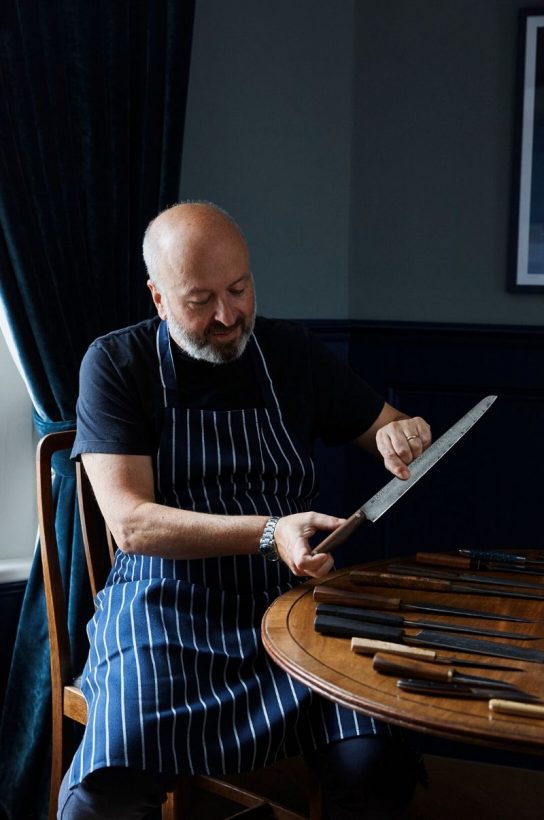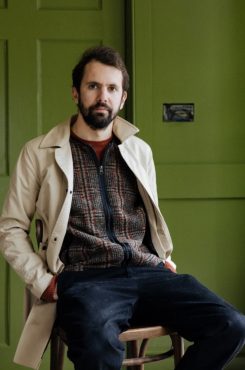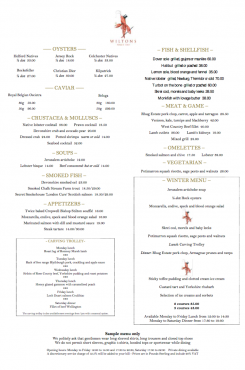Do you own a different knife for every occasion, or do you stick to one that is so precious no one else dares to use it? Harriet Prior asked five hospitality figures about the story behind their favourite knives. Photographs by Harriet Clare
Henry Harris
Former Racine chef Henry Harris now spends his time as chef director of the Harcourt Inns group of pubs, this summer transforming the legendary KPH in Ladbroke Grove. Harris also prides himself as knife fanatic, so naturally he couldn’t choose just one favourite.
“These knives have all come about in the last 10 years – I did leave a couple of my favourites at home! It’s all about the steel – you can put a nice handle on a knife but it really is about someone taking the metal and using heat to make it as refined as possible so that you can put a very good edge on it and cut relatively effortlessly, but also allow the food to look better on your plate. It’s a bug bearer of mine when you see supermarket adverts for roast lamb or beef, you can see it has been cut with a knife that’s not sharp enough, whereas if you cut a slice of beef with that (points to his knife), it would look almost like a polished wall with texture to it. I like having the right knife for the right job.
None of these knives you would use to cut anything with bones, or it might chip – when they forge well, they have a fragility to them. I look at what people offer up for sale and think that would be nice, but then I look, and I’ve already got one with the same function.
This is the first carving knife that Blenheim Forge ever made. People talk about these swirly patterns as being Damascus, but technically its pattern steel. The ones that are a bit rustic looking (far right) are the ones that I made on a knife making course. It takes two days to make a knife, unless you do it professionally in which case you can do it a lot faster. The little one is the remains from my first knife set when I was at Leiths; it’s literally been honed to nothingness. I’ve got about three or four left from the original knife roll.
I’m quite precise about not letting them touch each other, you never put them in the sink – but it’s about drying them well and then I also have some blade oil to give them a nice shine. I’m quite good at keeping protectors on which stops oxidization if they’re dry, and they don’t touch each other. And if someone comes charging into you, you don’t want to find them impaled on the end of a knife!”
Russell Norman
Russell Norman’s Polpo, which trailblazed the small-plate idea when it opened, celebrated its 10th anniversary this year. In 2018, Norman released his cookbook ‘Venice, Four Seasons of Home Cooking’, inspired by the time spent in his beloved Italian city.
“I’m not a chef, but I’ve always assumed that in order to cook properly you need expensive knives. However, I was in Italy just over a year ago writing a book about home cooking and I spent 14 months in a residential district in Venice. I wanted more than anything else to come away from that experience cooking like my neighbours – and most of my neighbours were 93-year-old grannies! In order to cook, think, behave and make food like these granny neighbours, I thought I should kit myself out with the equipment they use.
All of them, without exception, use knives like these: 2 and a half euros from the supermarket, short bladed, serrated. We’d probably call it a tomato knife, but they use it for absolutely everything. You’ll see the ladies cutting onions with it, chopping meat, chopping tomatoes and garlic and finely slicing herbs and it’s one of those differences I really enjoyed. There’s something humble and domestic about it that I love. I think it was that feeling of authenticity that appealed to me.
I bought a pack-of-six (in Venice) and because I only travel with hand luggage, I couldn’t bring them back, so I had to post them to myself. They are Italian, the brand is called Kaimano, although it doesn’t sound very Italian! The blade is deadly, I don’t know if they ever blunt!”
Merlin Labron-Johnson
After co-founding Portland at just 23, the award-winning chef Labron-Johnson has just opened his own farmto-table restaurant Osip in Bruton, Somerset, with a focus on local produce and sustainability. He also continues his role as executive chef of The Conduit.
“I’ve always loved utility knives, because I basically use them for everything that people use other knives for. It has to be slightly longer in order for me to do fish butchery with it. Loads of people I know have 20 different knives, but I’ve basically got a chopper and this. I’ve had it for three years, but I just buy the same one time and again. Once you start using a knife, it becomes an extension of your arm. Other knives feel weird or different.
You know when you see an experienced chef doing knife work and they just look up and start having a chat with you, and you’re thinking: you’re going to cut yourself! But it’s just your body doing what it needs to do, and I never ever cut myself. I take this everywhere I go, and I have one at home. I didn’t have any formal knife training- I really enjoy knife work with vegetables, I really enjoy chopping, dicing and slicing, I find it really satisfying. When I was at In De Wulf, I ran the butchery programme, so we’d get whole animals in from the local farmers and I’d butcher them, then we’d send different parts of animals to different restaurants. I kind of taught myself there from reading books.”
Sarit Packer
Sarit Packer and her husband Itamar Srulovich – the Honeys – co-founded Honey & Co in 2012, and since then have become some of hospitality’s most loved figures. Their Food Talks podcast is irreverent and fun. Sarit, who also oversees their two other sites, has ensured you can purchase a set of her favourite knives from their deli Honey & Spice.
“I got the first knife as a gift from our staff for Christmas a few years ago for the opening of Honey & Smoke. It’s a Florentine knife: they are hand-made with pieces of wood and metals and a composite material called Micarta. They got me a small one for Christmas, and then for my birthday I got a big chef knife. They are so beautiful, sharp and amazing that we started ordering them to sell in our deli. I’ve got one here (at Honey & Smoke) but the one here is probably the bluntest because it gets used all the time. Normally we wouldn’t put it in the kitchen, but we had a burglary at Honey & Smoke and they tried to steal our safe, but they couldn’t get into it. They shook the safe around and the spare knives were there, so it was already damaged a bit which is why it’s ended up in the kitchen. It’s been there since then!
At home I have one and my husband has one and we’re not allowed to touch each other’s. His is a full wood handle with gold and mine is all colourful and beautiful. We take care of them, make sure they’re dry. They cannot go in the dishwasher by any means because they’re hand-welded together. I pretty much use one knife for everything, it’s amazing! We’ve done ones for Christmas now that are orange, red and black – they’re really gorgeous.”
Lee Tiernan
Lee Tiernan is the chef/owner of Black Axe Mangal, combining his classic St.John training with out-there dishes, although the fabled Deepthroater rests in peace. Famously, the restaurant plays music at ear-bleed volume. He’s just published his first, eponymous, cookbook.
“Are we going to get arrested if we expose them (the knives) on the street? I’ve got a lot of random stuff in my bag, should we just look like we’re selling them on the street?
One is an oyster shucker. Then there’s a nice general-use knife for vegetables and small pieces of meat and the green one is for boning. They’re from Fingal Ferguson in Gubbeen farm in Ireland. He’s closed his books now; he’s got a 10-year waiting list. He could make 10 a day for the rest of his life and still never reach the end of his list. He spends loads of time on the handles: I’ve got one at home that has shredded dollar bills in it! I’ve got another one at home which is ancient bog oak from Cork.
I’ve not sharpened these ones yet. I think that might be one of the reasons I neglect them, because I’m a bit ignorant on how to sharpen them. I always go for a long, serrated knife and once it goes blunt it just sits in a box in the kitchen never being used and I’ll buy another. I like a knife that you don’t have to sharpen every 10 seconds to keep a good edge. I’ve had these for about three months. I’m determined to look after them, all the rest I’ve kind of abused. Although I think a knife is to be used, right? A knife will last you forever if you take good care of it.”
This article was first published in the 2019 winter edition of the CODE Quarterly. To read the latest long reads, subscribe to the CODE Quarterly here



